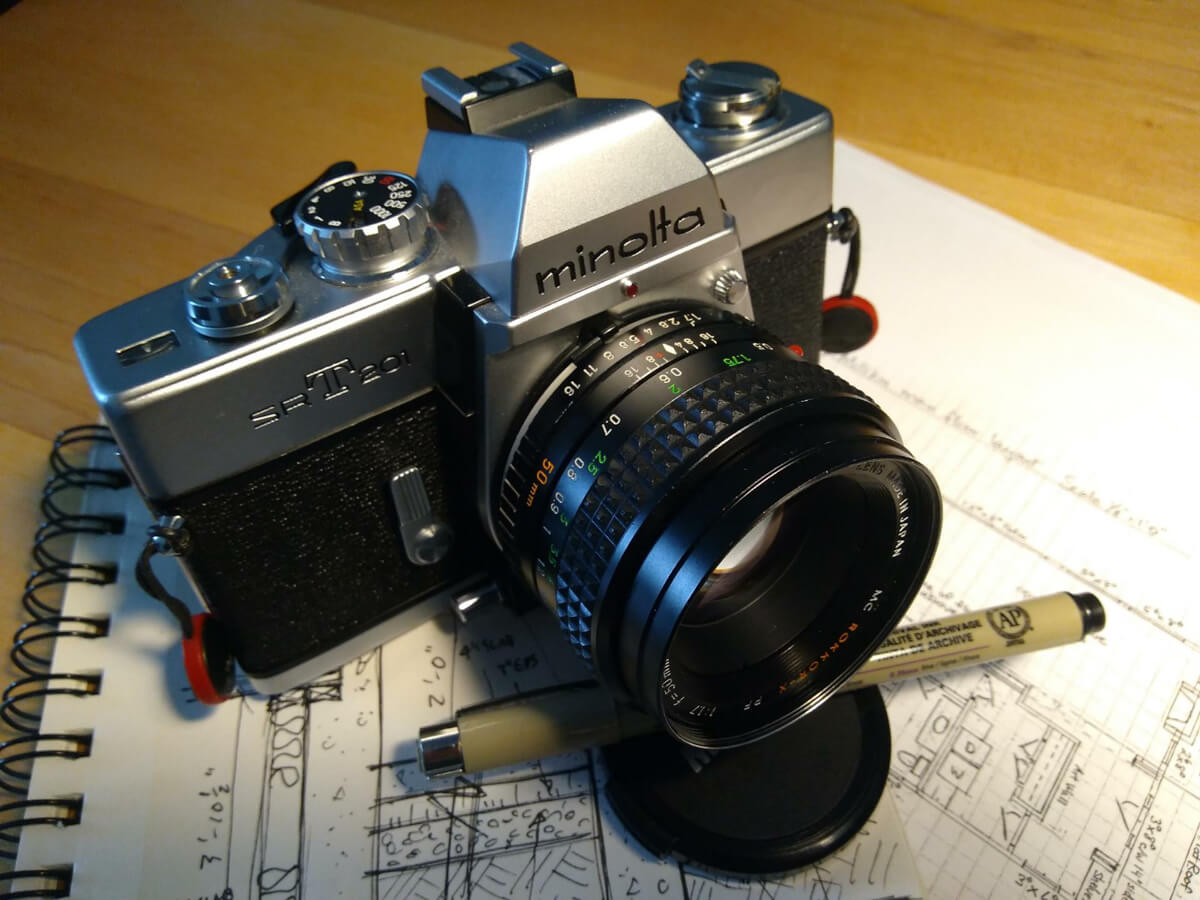
The self-timer is used to delay release of the shutter for about 10 seconds. The stop-down button has two settings, one for full-aperture metering and the other for stop-down metering or depth-of-field preview. Let’s look at the various dials and controls as well as the film loading and film travel methods. The SR-T 201 and its peers contain more metal and less plastic than modern cameras. When comparing cameras from that time to modern DSLR or mirrorless cameras you might find those old cameras to be small in size but with a heavy feel. A range of new MC lenses were introduced between 19, when they were superseded by the MD Rokkor line in 1977.The 35mm SLR film consumer camera market in the time this camera was sold new included comparable high-quality models from brands such as Pentax, Canon, Nikon, Ricoh, Nikon, Olympus, Fuji and others.

The SR-T 101 retained compatibility with the earlier lenses with stop-down metering. Two new optical designs were introduced in the 55 mm 1:1.7 and 135 mm 1:3.5 the others were upgrades of the older Auto Rokkor lenses. These had 55 mm filter threads except where noted.
MC Tele Rokkor-QE 1:3.5 f=100mm (52mm filter). MC Tele Rokkor-PF 1:2 f=100mm (62mm filter). Ī new line of Rokkor lenses were launched with the camera featuring the MC full-aperture metering: The range of Rokkor lenses became quite extensive and included highly respected designs like the Macro Rokkor-QF 1:3.5 f=50mm and the extremely rare MC Rokkor-PF 1:2 f=100mm. MC Rokkor-PF 1:1.9 f=55mm – size 52mm filter. MC Rokkor-PG 1:1.2 f=58mm – size 55mm filter. MC Rokkor-PF 1:1.4 f=58mm – size 55mm filter. MC Rokkor-PF 1:1.7 f=55mm – size 52mm filter. Two alternative standard lenses were also made available for the Minolta SR-T 101 the 1:1.7 f=55mm is the economy model, and the 1:1.2 f=58mm the most expensive alternative: The MC refers to the aperture meter coupling, required to operate properly on the SR-T 101, and the PF to the lens construction comprising a five group design using six glass elements. The normal standard lens for the Minolta SR-T 101 is the MC Rokkor-PF 1:1.4 f=58mm. Standard MC Rokkor lenses for the SR-T 101 The parts still chromed, to name the most obvious ones, include the shutter-release button, the mirror lock-up knob, the depth-of-field preview button and the lens-release button. The top cover and the base plate are finished in black enamel while most metal parts are black chromed, but the wind lever is black anodised. The SR-T 101 was also available in black. Shutter speed and match needle exposure is visible in the viewfinder, including a battery check index mark showing the required meter needle deflection for a healthy battery when the ON/OFF meter switch on the camera base is set to BC. ĭue to a large pentaprism and double-hinged reflex mirror, the SR-T 101 has an extremely bright viewfinder with a central micro prism focusing aid that in most cases proves to be appropriate, requiring no apparent lines in the motive, since all out of focus objects appear to shimmer. Because of this, Minolta recommended SR-T 101-users to first meter the photographed area and then to swing up the camera for taking the picture to enable the "CLC" an accurate metering. This system works for almost every landscape-format image regardless of the metered contrast range, but requires a much more skilled usage when it comes to portrait-format images. Landscape photographs with a large area of bright sky and a smaller area of dark ground, for example, are automatically corrected by the contrast-matching "CLC"-metering system. Therefore the metering system always detects an average of the light travelling through the lens, determined by the contrast division of the metered motive. "CLC" stands for "contrast-light-compensation" and was a kind of an early Matrix metering: Two CdS-cells, placed at the front and rear end of the viewfinder prism, provide an overlapping coverage of the center-weighted light-detection area and are electronically coupled together. #Minolta camera srt 201 full#
Full aperture TTL metering was commercially first realised in the 1963 Tokyo Kogaku Topcon RE Super.Īnother unique feature of the SR-T 101 besides the open aperture metering at the time of its release to the public at Photokina in 1966 was the so called "CLC"-metering characteristic. The most significant one is perhaps the full aperture metering facility, allowing the exposure to be set accurately without stopping down. The SR-T 101 however, has several significant features apart from the TTL meter. The design is based on the Minolta SR-7 model V camera of 1962, but the principal design is inherited from the original 1958 Minolta SR-2.

2 Standard MC Rokkor lenses for the SR-T 101.






 0 kommentar(er)
0 kommentar(er)
